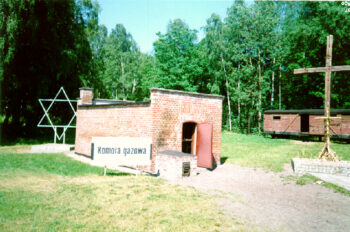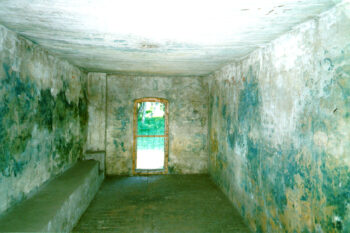Stutthof
Just one day after the outbreak of open hostilities between Germany and Poland, the German authorities established a detention camp near the town of Stutthof, some 20 miles east of the City of Danzig, meant to contain anti-German Polish political activists. This region had been separated from Germany after the First World War and was formally subject to the supervision of the League of Nations. However, ever since the end of the First World War, Poland had tried to gain total control of it with several repressive and provocative measures. This was one of the main reasons for the German-Polish conflict.
Since 1941, the Stutthof Camp also served as a “labor education camp” for individuals who had violated their labor contracts in any way. In 1942, the camp officially obtained the status of a concentration camp, with the aim to serve the surrounding farms as a forced-labor pool.
Extant documents show that the main purpose of the Stutthof Camp during the later phase of the war was systematic data gathering of concentration-camp inmates in order to deploy them more efficiently in Germany’s economy. Hence, Stutthof had been turned into a large labor reservoir and distribution hub for forced laborers for the German war economy. Hence, large transports of Jews were coming into Stutthof, and they left the camp as well.
Within the context of the Holocaust, this camp becomes interesting as we enter the year 1944, when its prisoner population increased drastically due to the massive influx of Jewish inmates who were transferred from the Baltic countries, as well as from Hungary and Poland via Auschwitz.
The orthodox Polish narrative, which was clearly molded by Stalinist war propaganda, has it that in 1944 the camp was converted into an “auxiliary extermination camp” in order to support the mass murder allegedly simultaneously unfolding at Auschwitz. However, instead of killing its Jews, it is well-documented that, from July 1944, thousands of Jews were transferred from Stutthof to other concentration camps in central and west Germany. Two transports with some 2,000 inmates were even sent to Auschwitz. They consisted mainly of women with children who had been evacuated from the Baltic countries. Hence, if Stutthof was an “auxiliary extermination camp,” it did a terrible job.

 Stutthof Camp, inside view of the Zyklon-B fumigation chamber, with intense blue wall stains of Iron Blue, caused by exposure to hydrogen-cyanide gas.
Stutthof Camp, inside view of the Zyklon-B fumigation chamber, with intense blue wall stains of Iron Blue, caused by exposure to hydrogen-cyanide gas.Claims about the existence of a homicidal gas chamber at Stutthof rest on shaky ground:
- No documents exist supporting the claim that a homicidal gas chamber existed at the Stutthof Camp, or that any such gassings occurred.
- Although no physical evidence exists for that claim either, it cannot be ruled out categorically that the camp’s Zyklon-B fumigation chamber, a small building of just 8.5 m × 3.5 m, could have been used as a homicidal gas chamber.
- However, this building could be observed by all inmates. Considering that between 20 and 50 inmates were released from Stutthof every day, even including the time period during which homicidal gassings are said to have been carried out, these alleged gas murders would have become known everywhere fast.
- The extermination claims are linked to claims about the local crematorium’s cremation capacity, which was grotesquely exaggerated by these witnesses, throwing an unfavorable light onto their trustworthiness.
- Claims about the number of victims, their ethnic and religious affiliation, as well as the dates of these gassings are contradictory, very vague and contain at times obvious propaganda. Some witnesses even claimed that inmates were gassed in narrow-gauge railway cars.
While these are not conclusive arguments against claims about homicidal gassings, the evidence offered to support these claims isn’t convincing either.
In the wider Holocaust context, the Stutthof Camp is significant less for its alleged homicidal gassings than for the inmate transfers from and to this camp starting in the summer of 1944. These transfers have far-reaching repercussions on the entire orthodox Holocaust narrative.
Beginning in late June 1944, large transports of Jews arrived at Stutthof, mainly either from the Baltic countries or from the Auschwitz Camp. The first set was the result of the Red Army advancing into these countries, leading to the evacuation of all sorts of camps in that area, while the second set consisted of Jews from Hungary and the Lodz Ghetto, for whom Auschwitz had only been a transit camp.
These transports seriously undermine the orthodox extermination narrative for two reasons:
- Some of the inmates from the Baltic countries were German Jews. According to the orthodox narrative, however, these Jews are said to have been murdered on arrival in those Baltic camps several years earlier. The data about the Stutthof Camp prove that at least some of them were not murdered.
- If we follow the orthodox narrative, the vast majority of Hungarian Jews deported to Auschwitz since May 1944, as well as the Jews deported to Auschwitz from the Lodz Ghetto in August 1944, are said to have been murdered on arrival without having been registered. The data about the Stutthof Camp prove, however, that at least some of these unregistered Jews (23,566, to be precise) were not murdered on arrival but were transferred to other camps as forced laborers.
It is unlikely that all Jews from the Baltic countries, Hungary and Lodz who were transited through Auschwitz in the summer of 1944 eventually ended up in Stutthof. After all, Stutthof was only a relatively small camp, and only one among many others. It stands to reason that many more Jews were sent elsewhere as well, of whom orthodox historians assume that they were murdered at Auschwitz.
For instance, it has been demonstrated that at least 79,200 of the Hungarian Jews deported to Auschwitz in the spring and summer of 1944, who were not registered there, were transferred to other camps. The orthodoxy insists, however, that not getting registered at Auschwitz meant immediate death in its gas chambers. This is evidently untrue. Had the Germans intended to kill those Jews, they wouldn’t have put them on a merry-go-round, crisscrossing Eastern Europe through numerous camps, but would have finished them off, once they laid their hands on them. Stutthof therefore also demonstrates that the orthodox conjecture about the mass murder of inmates who were not registered on arrival at Auschwitz is untenable.
The highest registration number assigned to a Stutthof inmate is 105,302, issued on 17 January 1945. A few days later, evacuation transports started. Hence this number is probably close to the maximum number of inmates who were incarcerated at Stutthof altogether. A thorough study of the camp’s various records shows that some 26,100 inmates died during the camp’s entire existence. More than half of them died in the final months of the war, from November 1944 on, when Germany’s collapsing infrastructure made it impossible, particularly in the east, to provide camps with anything they needed. A typhus epidemic, combined with starvation, dismal hygienic conditions and no possible medical care, were the main cause of these late fatalities.
Orthodox Polish historians have added to the documented number of deceased inmates some 39,000 more victims, thus reaching a death toll of 65,000. These additional victims were allegedly killed in the camp’s fumigation/homicidal gas chamber. However, there is no documental or material trace of these inmates ever having existed, let alone being murdered this way or any other way.
(For more details on this, see Graf/Mattogno 2016.)

You need to be a registered user, logged into your account, and your comment must comply with our Acceptable Use Policy, for your comment to get published. (Click here to log in or register.)